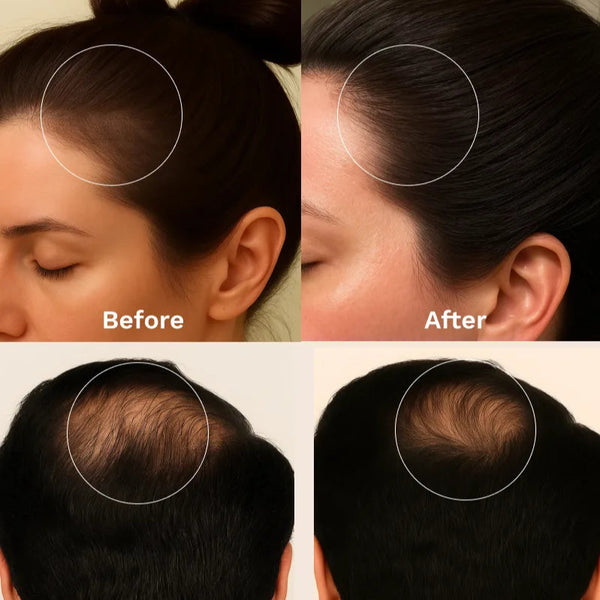In this article
Facing premature hair loss can feel heavy and personal, especially when you spot extra strands in the drain or on your pillow. You’re not the only one dealing with this. Early clues often show up sooner than you expect, so learning to spot them matters.
Here’s the good part: there are now more ways to treat thinning and balding than before. While genetics play a role, hormones, certain drugs, and stress can also speed things along. Pinpointing causes and warning signs early gives you the best chance to act and support regrowth.
Getting familiar with early signs and basic prevention steps can support your well-being and help you feel more in control.
Keep the following points in mind when you’re dealing with premature balding.
Key Takeaways
-
Early signs include crown thinning, temple recession, increased shedding, texture changes, and diffuse density loss.
-
Monthly home checks track change: hair pull counts, comb shedding, scalp inspection, consistent photographs.
-
Medical evaluation includes trichoscopy, scalp biopsy, and blood tests for hormones, iron, thyroid, nutrients.
-
Genetics influence loss, while hormones, medications, and stress accelerate; early detection improves regrowth odds.
8 Signs to Check if You’re Going Bald
Before you worry, use a simple, structured check. Look for early patterns doctors track:
-
Thinning at the crown
-
Receding hairline
-
Extra loose hairs after washing or combing
-
Changes in hair texture
-
Diffuse thinning across the scalp
-
Slower-than-usual growth
-
Photo evidence over time
-
Itchy or flaky scalp
Note what you see each month and bring it to a dermatologist if any sign persists. Early action gives you the best chance to slow loss and support regrowth.
Hair Growing More Slowly

Right now, there aren’t strong studies showing male pattern baldness changes hair growth speed.
Still, many people say slower growth seems to appear early on. Follicles age like the rest of the body, and growth rate can drop with time.
Typically, scalp hair grows about six inches a year, or roughly an inch every couple of months. If growth seems slower, it may accompany hair loss.
Noticeable Changes in Hair Texture

When follicles begin to miniaturize in male or female pattern loss, the remaining hair can feel finer and thinner. As shafts weaken, hair often looks less vibrant.
Without normal structure, strands can lose luster and seem dry even after washing and conditioner. A dermatologist can use trichoscopy to view the shafts up close and document texture changes.
Itchy or Dry Scalp

A dry, itchy scalp can appear with hair loss. Flaking or irritation may point to follicles under stress or damage.
If you notice these signs, talk with a trichologist or a doctor who focuses on hair loss. Assess what’s causing your loss and how advanced it is, then help plan care that addresses root issues.
Gradual Thinning on Top of the Head

One early clue is thinning and extra shedding at the crown. You may notice more scalp showing when your hair is wet. Watch for a wider part on top, concentrated shedding there, and hair that feels less dense over the vertex.
This steady thinning often goes with a receding hairline and enlarging bald spots. It happens as the hair growth cycle shifts too soon into telogen (the shedding phase), shortening anagen (the growth phase). With each round, follicles miniaturize and make finer, weaker strands. Over time, excess shedding can leave visible areas.
Keep an eye on the crown to catch male or female pattern loss early, when improvement is more likely. Use a hand mirror to check this spot regularly. The sooner you see thinning, the more options you have.
Recognizing a Receding Hairline

A receding hairline is a classic sign of male pattern baldness. Many men miss it until it’s obvious, either because it moves slowly or it’s hard to acknowledge.
Watch for the signs below:
Thinning Hair Around the Temples
Receding hairlines commonly start around the temples. Over time, the front can sit lower in the middle than at the sides.
About 25 percent of men ages 40 to 55 show this pattern, according to Male Androgenetic Alopecia.
When Hairstyles Start to Look Different
You might realize your hairline is beginning to recede when:
-
Certain styles reveal more forehead than you remember seeing.
-
You notice an M-shaped outline while washing or drying, with hair left at the sides.
-
A bit more scalp becomes visible toward the back of your head.
More Scalp Showing at the Crown
For some men, hairline changes begin at the crown, the highest point on your head. If you’re thinning there, you might see scalp through the hair when you check with a mirror.
Roughly 31 percent of men ages 40 to 55 show vertex baldness (thinning at the crown).
Loose Hairs on Pillow, in the Shower, or on Your Brush

Extra loose hairs can be one of the first hints that balding is underway. Noticing more strands on your pillowcase, in the drain, or caught in your brush or comb may point to a problem.
Normal daily shedding is around 50-100 strands per day as old hairs release and regrow. Regularly seeing more than that can mean growth cycles are off and early shedding is happening.
Collect a few shed hairs and have a dermatologist examine them. They can evaluate the bulbs and phases to help distinguish telogen effluvium from pattern hair loss.
Diffuse Thinning Across the Scalp

Sometimes premature loss spreads evenly across the scalp. There isn’t a single bald spot; instead the whole head looks less full, like the volume turned down.
With diffuse thinning, hair across your scalp moves too early from anagen to telogen before reaching full length. This pattern often relates to internal causes such as nutritional deficiencies, hormone issues, or autoimmune disorders.
If your scalp looks more see-through overall, consider checking thyroid and iron to find correctable causes. Addressing diffuse loss early can slow progression.
Photographic Evidence

If loss worries you, take photos of your hairline or crown every few months in the same lighting to watch for changes.
Comparing current shots with images from ten years ago can also give useful perspective.
How to Check for Early Signs of Thinning Hair

Easy At-Home Checks for Early Hair Loss
Between visits, simple at-home checks can help you track changes in a calm, supportive way. Try these monthly self-checks:
Hair Pull Test
This quick check can flag excessive shedding:
-
Wash and mostly dry your hair as usual. At about 90% dry, shedding is easier to gauge.
-
Hold roughly 50–100 hairs near the scalp between your fingers.
-
Work in sections. Pinch 50–100 strands close to the scalp with your thumb and index finger.
-
Pull away slowly with light, even tension. Count any hairs that release.
-
Repeat across your scalp. If more than 10–15 hairs release consistently, shedding may be increased.
Track your hair-pull counts each month to notice trends. I found a notes app made monthly tracking simple and consistent. Share your results with a dermatologist, who can tell if it’s pattern loss or temporary shedding.
Comb Check
This basic technique shows extra shedding you don’t always notice in the drain. Here’s the process:
-
Shampoo and condition normally, then rinse well.
-
With a fine-tooth comb, gently detangle sections of towel-dried hair.
-
Check for strands that collect in the comb after each pass.
-
Comb through all areas of the scalp and note any areas that shed more.
An uptick in hair pulled out during combing may suggest abnormal shedding or early genetic loss. Make notes to review with your doctor.
DIY Scalp Inspection
A hand mirror lets you scan your scalp section by section and keep tabs on any changes over time.
-
Check your hairline, crown, and overall fullness when hair is freshly clean.
-
Use a hand mirror to view the crown first. Note any widening parts or thinner spots.
-
Look at the front, sides, and back hairline for thinning areas.
-
Assess density all over. Is volume lower? Do you see more scalp?
-
Record what you see and track changes. Bring these notes to your dermatologist.
Being proactive helps you stay ahead of changes. Natural light near a window kept my photos consistent month to month. At-home checks complement office visits.
Scientific Tests to Detect Early Balding
If you notice signs of premature loss, remember it’s common and help is available. Meeting with a dermatologist is a positive step toward understanding and addressing what’s happening. Early action gives you the best chance to improve thinning.
Doctors use several methods to evaluate the scalp and hair and clarify what type of loss you have. Below are three common tests in simple terms:
Scalp Biopsy
This in-office test removes a tiny skin sample from a thinning area after numbing the site, so it’s comfortable. Examining the sample shows what’s happening to the follicles underneath.
A biopsy can identify specific conditions such as certain alopecias or fungal infections. It also confirms whether follicles are shrinking, which occurs in male and female pattern loss, and may reveal inflammation or scarring that harms follicles.
The results provide a baseline for future comparison. Ongoing shrinkage or reduced follicle density points to progression, and early recognition allows targeted treatment.
Trichoscopy
This tool is a handheld microscope with a camera that magnifies your hair and scalp. The specialized device can enlarge images up to about 70×, showing individual hairs and follicles.
With trichoscopy, your doctor can capture close images to check thickness and the health of your hair and scalp and look for infection or inflammation. It helps diagnose patchy loss (alopecia areata), guides transplant planning, and tracks progress by visualizing follicles.
Blood Tests
Because hormones, nutrients, and stress can influence premature loss, bloodwork can highlight potential internal causes. Common checks include:
-
Hormones such as testosterone and thyroid
-
Iron and ferritin
-
Possible deficiencies in zinc, vitamin B and other nutrients
-
Markers of inflammation
When hormone issues, low iron, or thyroid problems are caught early, treating the underlying condition can steady hair loss. Targeted supplementation may also support healthier growth.
Understanding the cause of your thinning gives you the best chance to improve it. Ask your dermatologist about these tests and act at the first signs.
Slow Early Balding with Keyoma Batana Oil with Rosemary
If the checks above point to early balding, you are not stuck with it. Act now. Document your baseline with photos in consistent lighting, repeat simple monthly checks, and book a dermatologist visit to confirm the cause and rule out correctable issues like iron or thyroid imbalance. Trichoscopy or targeted labs can guide a plan that fits your case.
Support your scalp daily. Keep styles low-tension, wash gently, and protect hair from heat. Prioritize protein, iron, zinc, and steady sleep. Consistency matters more than any single product.
Add a focused scalp routine. Try Keyoma Batana Oil with Rosemary to nourish the scalp and help reduce breakage while you work your plan. Massage a few drops into the scalp 3–4 nights per week, track changes monthly, and combine with your clinician’s advice. Start today to give new growth the best conditions to appear.
Featured Product
100% Pure Batana Oil + Rosemary
↓Best Batana Oil to Buy↓
1 Month
Subscribe & Save
- 30-day supply delivered monthly $35
- 30% off for life $6
- Free haircare essentials kit $33
- Free custom wooden comb $10
- Free scalp massager $15
- Free eco-friendly travel bag $8
- 30-Day Money Back Guarantee
- Free Shipping
- Online portal for easy cancel, skip, or pause.
1 Month One Time Purchase

- 30-day supply $50
- 30% off for life $6
- Free haircare essentials kit $33
- Free custom wooden comb $10
- Free scalp massager $15
- Free eco-friendly travel bag $8








